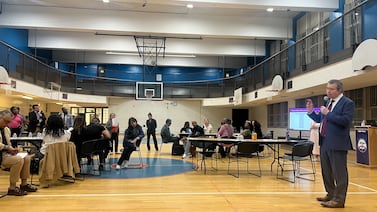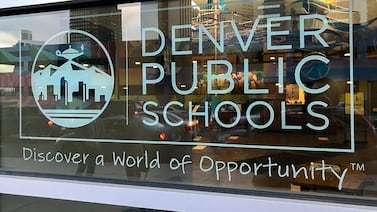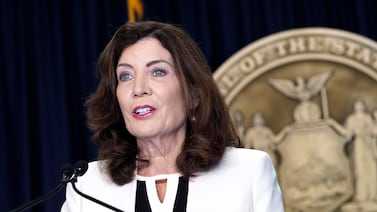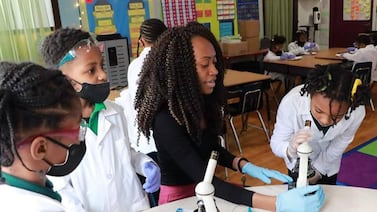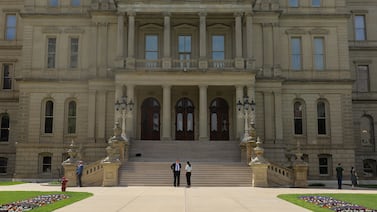To prepare for Colorado State University’s fall semester, D-L Stewart is putting together a plan that puts into place as many precautions as possible.
The professor, who is co-chair of the school’s Student Affairs in Higher Education programs — which teaches college administrators how to support students — plans for remote instruction when possible, a change to how he sets up classrooms, and a schedule that limits his time on campus. Stewart will make sure students all face to the front, instead of in a circle, and any students needing to attend remotely will be allowed to do so, he said.
The plans, however, don’t allow Stewart much peace of mind over the return to school, which comes with the possibility of worsening the spread of the coronavirus.
And for many professors and students, the pandemic is cutting into the usual excitement that accompanies a return to college life in the fall.
The coronavirus means major changes that are again expected to diminish learning and the college experience for some. And it brings about questions whether a return could put students and faculty at risk of sickness, or worse, death.
Stewart said schools are in a hard place because they need students to pay tuition or risk damaging their ability to teach over the long term due to diminished budgets.
“I’m concerned,” Stewart said. “I recognize why institutions feel the need to make certain decisions to reopen in some capacity, and I wish that we had structures and systems in our society that wouldn’t put public institutions in a situation where they have to think about costs — where they have to do cost benefit analyses — in the midst of a global pandemic.”
Most Colorado universities and colleges expect students back on campus in the fall.
The Colorado Department of Higher Education expects schools to follow guidance from the Centers for Disease Controls and Prevention to ensure a safe return to school.
The higher education department expects schools will reduce person-to-person interactions by 65% and allow anyone who needs it the ability to work from home.
The state will require plexiglass barriers between professors and students, room caps to allow 6 feet between everyone and designated entrance and exit doors in buildings.
Colorado State University is trying to balance safety and preserving the educational environment.
When possible, the school will allow students to attend labs and studios. Classes exceeding 99 students will move online. The school plans to move fully online by fall break, which begin Nov. 21.
CSU senior Kyle Robinette, a 21-year-old computer science major, said he understands the need for the changes due to the pandemic. Many students understand the safety precautions, he said.
That doesn’t change, however, how difficult it is to go through another semester with fewer services and life altered beyond school, he said. CSU, along with many other schools, moved fully online in March as the coronavirus began to spread.
Before the pandemic, Robinette had never taken an online course. He’d visit the career center, do his homework in study halls at school, and drop in during office hours if he needed help on complex assignments.
“I really enjoy, like, the community aspect of just being on campus,” Robinette said. “I don’t like doing work from home … it was a tough transition in the spring.”
Robinette said most of his classes are slated to have heavy online components in the fall. He considered taking a semester off because of the cost of tuition and he felt his education will suffer from remote learning.
“I know my education is going to suffer if it is online so it kind of concerns me but I also don’t want to put (graduation) off longer than I need to,” Robinette said.
Metro State University of Denver will also have many students participating in online learning despite some classes also meeting in person. The school sorted classes into three categories: on-campus required, on-campus preferred, and online-ready.
MSU Denver junior Andrea Garcia-Portillo, 20, who wants to become a teacher, said the fall semester delayed valuable hands-on experience in classrooms. She’s sad about losing on-campus experiences, she said.
But Garcia-Portillo also said she understands the precautions.
“I hope that, like, one day we do get to go back. But I feel like right now currently with everything that’s going on, with everything spiking up again, it’s just not a good idea,” she said.
University of Denver Professor Cecilia Orphan, an assistant professor of higher education, said despite the precautions, she believes the virus could appear on a campus. Professors are planning for an abrupt shutdown in the case of an outbreak.
Many public colleges, especially, have felt they need to maintain plans to open in person because they rely heavily on tuition and don’t want to discourage students from applying, she said. Students in the spring complained about a lackluster online college experience.
Meanwhile, schools that have large endowments, such as Harvard and the Massachusetts Institute of Technology, will remain remote.
And Orphan said she wonders what will happen if there is an outbreak. She asked: Will schools be held liable or be sued by students or faculty for returning to in-person instruction? And what happens if someone dies?
Recently, a custodial staff member at the University of Texas Austin died after contracting COVID-19, according to the Texas Tribune. And there have been 38 deaths within the City University of New York during the pandemic, according to Inside Higher Ed.
Orphan said the risk of opening is great. Younger people are less likely than professors to see fatal complications from the coronavirus. Custodial staff also are predominantly people of color or low income, she said, who have been impacted in greater numbers by the virus.
She herself has asthma and is worried about her health.
The risk for schools, Orphan said, brings about a moral argument.
Many schools must open in some capacity to account for fixed costs, such as staffing, or risk closures and loss of revenue that would hurt students now and in the future. For public schools in Colorado, diminished state support has placed colleges and universities in a tough situation. Student tuition makes up an outsized share of educational revenue.
“Even with the precautions, there is still a risk — and that risk is human life,” Orphan said. “It’s my hope that institutions will really emphasize and prioritize human life over their finances.”



